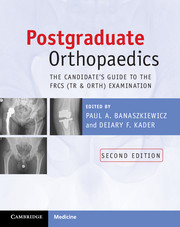Book contents
- Frontmatter
- Contents
- Contributors
- Foreword
- Preface to second edition
- Abbreviations
- Section 1 The FRCS (Tr & Orth) examination
- Section 2 The written paper
- Section 3 The clinicals
- Chapter 3 The short cases
- Chapter 4 The intermediate cases
- Chapter 5 Shoulder and elbow clinical cases
- Chapter 6 Hand and wrist clinical cases
- Chapter 7 Spine clinical cases
- Chapter 8 Hip clinical cases
- Chapter 9 Knee clinical cases
- Chapter 10 Foot and ankle clinical cases
- Chapter 11 Paediatric clinical cases
- Section 4 The adult elective orthopaedics oral
- Section 5 The hand oral
- Section 6 The paediatric oral
- Section 7 The trauma oral
- Section 8 The basic science oral
- Section 9 Miscellaneous topics
- Index
- References
Chapter 7 - Spine clinical cases
from Section 3 - The clinicals
- Frontmatter
- Contents
- Contributors
- Foreword
- Preface to second edition
- Abbreviations
- Section 1 The FRCS (Tr & Orth) examination
- Section 2 The written paper
- Section 3 The clinicals
- Chapter 3 The short cases
- Chapter 4 The intermediate cases
- Chapter 5 Shoulder and elbow clinical cases
- Chapter 6 Hand and wrist clinical cases
- Chapter 7 Spine clinical cases
- Chapter 8 Hip clinical cases
- Chapter 9 Knee clinical cases
- Chapter 10 Foot and ankle clinical cases
- Chapter 11 Paediatric clinical cases
- Section 4 The adult elective orthopaedics oral
- Section 5 The hand oral
- Section 6 The paediatric oral
- Section 7 The trauma oral
- Section 8 The basic science oral
- Section 9 Miscellaneous topics
- Index
- References
Summary
Introduction
Spine questions and cases are fair game in the exam. Although it is not expected that you will manage complex spinal problems as a day-1 consultant, the emergency management of spinal trauma is part and parcel of the initial management of the critically injured patient, especially in a district general setting. Also, many patients with spine problems present with brachialgia, leg pain or limitation of walking distance and may be referred to your general orthopaedic clinic. Congenital spine anomalies may initially be referred to the orthopaedic service, as may acute neurological dysfunction, or the initial assessment of patients presenting with tumours affecting the spine.
A few years ago it was entirely possible to get through the whole examination without being asked a single question on spinal surgery. This is no longer the case. The examination is now seen as a driver to improve the care of patients presenting with spinal problems, and their assessment, at least in an emergency setting, is seen as part of the trauma and orthopaedic curriculum. Thus, it is almost certain that, where possible, there will be at least one question on each viva table, and at least one short case in the upper limb section and possibly also in the lower limb section. It is not uncommon for patients with concurrent general orthopaedic problems to have degenerative stable spine conditions and these could easily form the focus of an intermediate case.
- Type
- Chapter
- Information
- Postgraduate OrthopaedicsThe Candidate's Guide to the FRCS (Tr and Orth) Examination, pp. 59 - 68Publisher: Cambridge University PressPrint publication year: 2012



